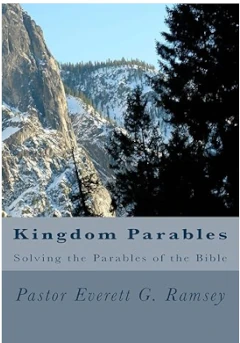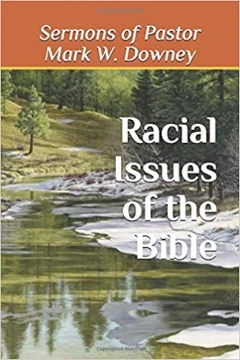The Holy Name Doctrine
by Jim Jester
October 18, 2020
Scripture Reading: I John 3:23
“And this is his commandment, That we should believe on the name of his Son Jesus Christ, and love one another, as he gave us commandment.”
Introduction
For many years, those in Christian Identity have felt isolated from mainstream judeo-Christianity; and indeed, we have separated from judeo churches for many good Scriptural reasons. We recognize different holy days rather than pagan holidays. We are not universal in regard to race, as they are, for we believe in the Covenant. We also have used different terms for the name of God to set us apart, most prominently, the “God of Abraham, Isaac and Jacob”. Many in our movement have also used alternate names for God, such as “Yahweh” and “Yahshua”. Some Bible translations use “Jehovah”. Some of us have not made a big deal over these names and have used them at times. Even judeo ministers have used them, along with us in C. I., of which, some have been very insistent and dogmatic about these names.
I think it is time to examine the doctrine of the Holy name. Much of this study comes from iSawtheLightMinistries.com, which I have greatly edited because of its length. For most of us, it will be a bit overwhelming. I have tried to keep it simple. If you get “lost”, don’t worry, I got lost too… at first. But be patient (this is necessary) and the simple part will come near the end.
You may have noticed in the Scripture reading, that there are two commandments given here. 1) That we should believe on the name of His Son; and 2) that we love one another. The little phrase “name of” appears 59 times in the N. T. and nearly always refers to Jesus Christ.
“Now I beseech you, brethren, by the name of our Lord Jesus Christ, that ye all speak the same thing, and that there be no divisions among you; but that ye be perfectly joined together in the same mind and in the same judgment.” – I Cor. 1:10
“I beseech you brothers” in the name of… who? Is it Jesus Christ or Yahshua? What difference does it make? The difference is that both cannot be correct. One of these names is a wrong. Furthermore, God would have us of the “same mind” or in agreement as a church body.
Now, I am not a scholar of ancient languages, especially Hebrew, Greek, or Latin, so do not consider me one. I will not attempt to teach you Hebrew (that would take more than one class). I know little of the grammar and syntax of those languages. I am not very good at even diagramming a sentence (in fact, I have forgotten). I do however, know what makes sense to me in English. When it comes to hermeneutics and exegesis of the Bible, I know that one cannot base a doctrine on one verse of Scripture, nor can we build a doctrine simply by defining the original words. Yes, words are important and have meaning, but we must also consider the context and if there is a figure of speech or any symbolism involved in the text.
Traditional Teaching
Most people are taught that in the original Old Testament, the name of the creator appeared as YHWH or perhaps YHVH, and then people add vowels between each letter, in order to translate it into Yahweh, Jehovah or some other variation of the Y names such as Yehovah, Yahshua, Yeshua, etc. All of these names are based upon the letters of YHWH or JHWH. And this is why many people believe that “Jesus” should be written as “Yeshua” or some other Y name variant.
The first thing to understand is that when one goes to school in Israel, they teach that the language of the jews is not the original Hebrew language. The style of writing letters is also not original Hebrew. Historical records show, that the style of writing the Alphabet is called “the Assyrian Script”.
Tongue of the Chaldeans
When Israel was taken captive by Babylon, the original true Hebrew language, called “Paleo-Hebrew”, was banned by Babylon and so was the original name of the Creator. The Israelites were forced to learn, speak and write the Assyrian language and script, which both the Assyrian Empire and the Babylonian Empire used.
Daniel 1:4, “Young men who were strong and healthy, good-looking, and trained in all wisdom, having a good education and much knowledge, and able to take positions in the king’s house; and to have them trained in the writing and language of the Chaldaeans.” – BBE
It was a well-known fact, that Daniel wrote Daniel 1:1 until Daniel 2:4 in Paleo-Hebrew. But when he came to verse four, he started writing in Assyrian, Babylonian Aramaic. This change of language was required by the king. The Israelites eventually translated the entire Scriptures into the Assyrian language in a new corrupt bible called “the Targum” and almost completely lost their original language.
To this very day, the jews do not speak Hebrew, but rather Assyrian Aramaic, but with a jewish dialect. All of this is documented history!
Modern Hebrew Is Not Original Hebrew
When we look at Strong’s Concordance of the Old Testament, it says “Aramaic dictionary” and if you have an older copy, it says “Chaldean dictionary”!
When we look at most websites that proclaim the Y names, what they are calling the “Hebrew” language is not the earliest Hebrew language. They are pointing to the Assyrian, Babylonian language, and they often are completely ignorant of these basic facts. They are not aware that it is only called “Hebrew” because it had become the language of the Hebrew people while they were in captivity. Strong’s Concordance does not give us the Hebrew words of the original Bible! Instead, it gives us the Assyrian, Babylonian Aramaic words.
Aramaic
The original Scriptures did not have the four-letter Tetragrammaton of YHWH. The four letters are “Modern Hebrew”, which is really Babylonian Aramaic. They did not appear in the original Scriptures and Moses did not write them. They are Aramaic (Modern Masoretic Hebrew), which did not exist during Moses’ lifetime. Moses would have written during 1446-1406 B.C. in the older Paleo-Hebrew. The Aramaic language did not exist until around 900 B.C.
This chart does not include all languages throughout history.
Note how “Syriac” and “Hebrew” are brother languages of the Aramaic (Assyrian). Yet, Old Hebrew (or Paleo-Hebrew) is not. They both evolved from the Phoenician language, but Paleo-Hebrew and Modern Hebrew are two different branches. Note also that “Old Hebrew” (Paleo) is listed as a brother of Greek. True ancient Paleo-Hebrew looks and sounds like Greek. God has preserved His Word through the Greek Septuagint, in fragments we have of the older Paleo-Hebrew, and through the Alexandrian Text.
History also shows that the Greeks attained their language from the Israelites. Modern Hebrew (the so-called “Hebrew” of Strong’s Concordance) and Babylonian Aramaic look and sound alike and are actually the same! Therefore, Strong’s does not point to true Hebrew (Paleo). It refers to the Assyrian language.
Examine closely any hard copy of the Strong’s Concordance. Notice in the “Hebrew” section, that it says “Hebrew and Chaldean Dictionary”. Pick any page of that dictionary, and notice how it says “(Chaldean Origin)” for not just one word but several words, on every page! The common claim is that the Aramaic language is used only in the books of Daniel, Ezra and a few other places. However, if you examine all the facts, all of the “Hebrew” words are actually of the Aramaic, Babylonian, Chaldean or Assyrian languages, not true Hebrew.
The fact is that the original Old Testament Scriptures were translated more than once. As generations passed, and language evolved, Israel was affected by that evolution during the captivities. Thus, the Scriptures were translated into the language of each era; and the same process continues today.
What Was Originally Written?
The Scriptures were originally written in Paleo-Hebrew (older true Hebrew), then eventually translated into a jewish dialect of the Babylonian language of Chaldean/Aramaic. Aramaic replaced the ancient Paleo-Hebrew.
Let us look at how the name of the Creator was written in the Paleo-Hebrew language in the scrolls of the oldest known fragments of the Old Testament. This image is of a fragment called “11Q5”. It dates to around 100 BC. It contains Psalm 121.
The scrolls were written in Aramaic. But when the scribes wrote the name of the Creator, they wrote his name in Paleo-Hebrew. This is why his name really stands out (notice underlined areas) and appears different from the surrounding text. This is because these scribes understood that the holy name should never be translated, corrupted, or changed. When they wrote the Creator’s name, they were sure to write it correctly!
1. Reading from right to left, the first letter is the ancient Hebrew Jot/Jota/Jud. Y name followers erroneously call it the “Yod” because they are focusing on letters and sounds of the Assyrian language. It looks like Z with a line through it. But it does not have the modern English Z sound. According to what other sound it was connected to in a word, it could have the sound of J, E or I. Since it was connected with the vowel sound of the next letter, it must have the J sound.
2. A website at www.orbilat.com/Languages/Latin/Grammar/Latin-Pronunciation-Syllable-Accent.html shows the mandatory rules of the Latin language. The fact is that Latin is just a form of Greek, which is a form of Paleo-Hebrew. Latin is related to Paleo-Hebrew (NOTE: The rule of J sound applied to Latin, Greek and Paleo-Hebrew). In the source article, the first mention of the letter J sound, includes this quote:
“For convenience we will use the letter j (named jota) to mark the sound, as it is common from the Middle Ages onward.”
It does not say that the j sound started in the middle ages, but was common in the middle ages. Then at the bottom of the article it says:
“By the epoch of the late empire (3rd and 4th c.), the diphthongs ae and oe were equalized with the short e and au with the short o. The pronunciation of y coincided with that of i and by then the letter name ypsillon was replaced in the popular language by i graeca Greek i.”
It does not say that it was pronounced Y in every word and combination of letters. The first section mentioned already declared rules for when it was pronounced with the J sound. Nothing in the bottom section demands a Y sound in every word possible. Then it says:
“The most important phonetic change of that period was, however, the palatalization of c and g before the anterior vowels e and i and the equalized with them ae, oe and y.... G was palatalized in all the Latin speaking world to [D3]. The consonantal i [j] was also transformed to [D3].”
3. The only thing this says is that in the Latin language the J sound became mandatory in the 3-4th century, which is more than 1500-1600 years earlier than the Y name people claim! The article doesn’t prove beyond any doubt what sounds existed and did not exist in the lifetime of Jesus and before. But it does prove that the J sound is much earlier than the Y name people want to admit. The article does not prove that the Y sound was required in every word. This article is enough to cause a huge earthquake in the foundation of the Y name doctrine.
4. The next letter almost looks like a Y; but this is not a Y like the one we use in English today, and also not the Yod they used in Assyrian Aramaic. If we look at all four letters of the divine name and render this letter as only a U sound without any consonant sound, then we would have four vowel sounds together, which would be impossible to speak as a name. The fact is, some letters represented both vowel and consonant sounds, such as is true with the first letter.
Question: Where did these rules come from in the 3rd century A.D.? Of course, it would have come from the usage of words before the 3rd century. Words, sounds and letters are always used by the population before being declared mandatory by the authorities.
Y name followers claim there were no vowels in Hebrew. But how could one write, read or speak without vowels? That’s nonsense! Archaeological discoveries of coins, etc., prove that there were vowels. The respected historian, Josephus, of the first century, said that the priest of the first temple wore the name of God on their headbands and that it was four vowels (War of the Jews 5.5.7., Flavius Josephus).
Jesus is the Sacred Name
Therefore, we have the four letters JEUE or JESE as the original four letters for the Creator’s name; but the Hebrew sound of the third letter would need to be represented by two English letters for us modern day speakers. Thus, in our modern way of writing, it would be “JESUE”.
All 4 letters of JEUE were considered vowels, even the J, because the Jot/Jota/iota character could be used to have either the J sound, or the E or I sound, depending on the other sounds within the word. Since it was connected with three other vowels, it must have the J sound, because that is the rule of language.
The U was also a semi-vowel having both the short u vowel sound and consonant S sound. But all four letters were considered vowels since they had the connection of possible vowel sounds in certain cases. However, it would be illogical to think that we could pronounce the holy name as four vowel sounds, even though it was written as such. We must have consonant sounds in a word.
The rule of the Greek language (a Paleo-Hebrew language) is that you add the S sound at the end of JESUE to show that it is a masculine word. Then the U sound blends in with the final E to make one sound mixed with the final S sound, thus we have “Jesus”, pronounced “G’s-us”.
The problem with Y name followers is that they try to force every Assyrian so called “Hebrew” pronunciation upon every Paleo-Hebrew letter, which is impossible to accurately do, because Paleo-Hebrew and Aramaic are two distinct, mostly unrelated languages. It is more accurate to place ancient Greek pronunciations upon Paleo-Hebrew. Thus, applying all the rules of language, we should pronounce the ancient name as “Jesus”.
English and Jesus is Hebrew
English comes mostly from Greek, which is Paleo-Hebrew. The USA and British Commonwealth are the descendants of the “lost” 10 tribes of Israel and so English still maintains many Hebrew sounds.
In Exodus 3:14, “And God said unto Moses, I Am That I Am.” According to Strong’s Concordance (which is Babylonian Aramaic), the words “I AM That I AM” comes from H1961 H1961: “hayah hayah”. However, in the Paleo-Hebrew scriptures of this verse, it actually said: “EHJEH ASHER EHJEH” (Pronounced I-JE Asher I-JE). EHJEH is pronounced like the two letters I and G, but the letter G is not an accurate way to write the word.
God was saying, “I am JE”, which is the more accurate way to write this sentence. But He did not use the word “am” in the middle. He did not say, “I AM” because thousands of years ago, they did not use so many words. They spoke very short sentences. He said, “I JE”, which means, “I am JE”.
God was not saying that his name was “EHJEH ASHER EHJEH”, but rather He was speaking a sentence that basically says, “I am JE the beginning, currently self-existing, and eternally existing, JE.” He was saying, “I am Jesus.”
- Considering EHJEH “I (am) JE” in Exodus 3:14 and that it meant that He is the Alpha and Omega, which Jesus claimed He was in the book of Revelation
- and “JESUE/Jesus” in Ex. 6:3 and most other places in the Bible
- and “Jesus”, abbreviated as “JE” in many early New Testaments
- and the name of “Jesus” in both early and modern New Testaments, the conclusion must be that the Creator’s name in both the O. T. and N. T., in Paleo-Hebrew, Greek and English is “Jesus”. His name does not change in different languages [so with Hallelujah], because He is the Creator.
Other False Religion Connections
We must admit that the Scriptures were translated many times from one language to another during each era, just as we witness in modern times. We must admit that the original name that God spoke (and Moses wrote) was not the four letters YHWH. The Tetragrammaton and all the translations from it are all Babylonian Aramaic. Even the Encyclopedia Britannica 1958 edition, Volume 12, page 996 says: “...Yahweh is not a Hebrew name.”
When Israel was taken away into Assyria, Babylon and Egypt, they adapted to many Babylonian customs, traditions, religious beliefs and use of words. The Assyrians and Babylonians even moved into the land of Israel (2 Kings 17:24). Before Babylon, they kept the Sabbath from sunrise to sunrise. When they came out of Babylon, they were observing Sabbath from sunset to sunset. They adopted Babylonian names of the months. They had adopted the Babylonian Talmud. They also adopted the names of Babylonian gods and Kabbalah witchcraft. Smith’s Bible Dictionary of 1878, page 207 says that moon worship was re-introduced into Israel by Manasseh around 698 B.C. They called the moon the Queen of Heaven. This is all related to the pagan roots of Christmas and Easter. They even changed their alphabet, from Paleo-Hebrew to Aramaic. In Babylon, they also translated the Paleo-Hebrew Scriptures into Chaldean (Babylonian) Aramaic.
The word “Chaldean” means “moon” or “moon worshippers”, thus, Chaldean is the language of moon worshippers. The word “Chaldea” also means “Astrology” which is the language of witches. YHWH is actually the Tetragrammaton name of Baal/Lucifer/Satan; and all translations of it refer to witchcraft.
Therefore, we see the names of Babylonian gods inserted in place of the true original sacred name that God and Moses spoke. Babylonian Aramaic replaced ancient Paleo-Hebrew, and nearly all manuscripts, including the Masoretic text and the majority of the Dead Sea Scrolls, are in Aramaic.
Jesus, the Apostles and the early Christian Church never used or quoted from the Authorized Version created in 1611 under influence of the pope. They never used or quoted from any of the Masoretic Text that was copied, edited and distributed by a group of jews known as the Masoretes between the 7th and 10th centuries AD. The Masoretic text also leaves out entire books that were in the Septuagint. However, Jesus, the Apostles, and the early church certainly did use and quote from the Greek Septuagint.
Here is what Yahshua means in the jewish language of the Masoretes. This acronym, formulated by the rabbis in the early centuries after Jesus, really means, “Let His name and memory be blotted out.”
“Yah” refers to the Egyptian moon god (Source 2) and is also related to Osiris the Egyptian god of the dead. During the Assyrian and Babylonian invasions of Israel, not only were they carried off into Assyria and Babylon, but also Egypt. Much of the Assyrian and Babylonian beliefs came from ancient Egypt.
Yah and Thoth are related to the moon god named “Sin”. Although the names of the moon god was Sin, Thot, Thoth, Yah, Pan, etc., his title was Al-ilah, meaning “the deity”, i.e., he was considered the chief god above all gods. The moon god called Al-ilah was shortened to “Allah”. The pagans used Allah in the names they gave their children. Both Muhammad’s father and uncle had Allah as part of their names (Source). Yah/Yahweh is none other than Allah, the Islamic pagan moon god, and the archenemy of the One Eternal Almighty God, Jesus the Christ.
Archaeological records show much proof that the god of the Yah names is the same god of the ancient Assyrian pagan so-called “star of David”. (Ref. 1, Ref. 3)
A Reference to Witchcraft
Notice in this witchcraft tarot card that each letter of YHWH is present between each letter of “tarot”. When rotating the opposite direction, tarot would read tora. Why is the Tetragrammaton on a Wicca card?
Each Chaldean Letter of the four letters YHWH is present on the Tarot Card.
Witchcraft Tarot cards are Assyrian jewish Astrology worship. Witches and Satanists chant the four letters of YHWH. Now, why would witches and Satanists chant the letters of the true sacred name of the Almighty? They wouldn’t and they don’t! They are actually chanting the name of their pagan moon god Allah/YHWH (Source 1, Source 4, Additional info on tarot cards).
YHWH is associated with occult pentagrams. See inside triangle/all seeing eye/sun inside the Catholic church, 5th Chapel of the Palace of Versailles in France.
Why would the Holy Name of our God be connected to evil like this?
The Creator knew that the pens of the scribes and translators would be corrupted and substitute the names of Baal for the true name, and foretold it.
Jeremiah 23:26-27, “How long shall this be in the heart of the prophets that prophesy lies? yea, they are prophets of the deceit of their own heart; Which think to cause my people to forget my name by their dreams which they tell every man to his neighbour, as their fathers have forgotten my name for Baal.”
There is only one name where there is authority, power, and salvation. That is Jesus! Jesus is the correct Hebrew name of God. It is not Greek, nor Latin. It is the English spelling of an ancient Hebrew name that is universal to all languages. In the 1611 KJV, Jesus was spelled with an I instead of a J. However, it had a J sound. Greek has a J sound, and original Paleo-Hebrew had a J sound. There was no Y in Paleo-Hebrew.
The Old Testament pointed toward the arrival of Jesus. If we want to know the name of the Father, we need to look no further than Jesus, who is the “express image” (Heb. 1:3) of the Father. The name of Jesus is the name of the Father. We have only one God. Jesus said that He came in his Father’s name. When a man has his father’s name, they both have the same name. Acts 4:12 says that “Jesus” is the only name by which mankind may be saved. Zechariah 14:9 says that in the Kingdom, “…shall there be one LORD, and his name one.” We will not be serving or pronouncing two names of God.
Conclusion
Christian Identity has used the Yah names for many years and have felt that it is a part of our distinctiveness as a church. However, when we learn new things, we should not be too proud to admit that we were wrong. It was not sinful to use these Yah names for we did not know that there was a Paleo-Hebrew. We were simply ignorant of that fact, and innocent in the eyes of our God. Christians are seekers of truth, and when we find new truth, we should adjust accordingly.
If someone confronts you to defend the Yah words, simply remind them:
- The Y words come from the wrong Hebrew. Our position is based upon the older Paleo-Hebrew, not the post-Babylonian Hebrew that followed Israel after their exile and return to the Holy Land.
- Jesus used the Greek Septuagint, not a Hebrew Bible as judeo-Christianity has traditionally taught (or lied about).
- The Tetragrammaton (the claimed justification for the Y words) is not a name, but a title.
It is as simple as 1, 2, 3.
On a historical note, you will recall that the Apostle Paul preached to what remained of the Celtic priesthood on his missionary journeys. Perhaps one of the reasons why the ancient Celtic priesthood accepted Christianity so readily was that their “Gee-sus” was pronounced as our “Jesus”, the ancient Paleo-Hebrew pronunciation. The Celtic priests were isolated and unaware of the Babylonian change in the Hebrew. They did not use the Modern (Yiddish) Hebrew “Yashua” or any of the Yah variants. Neither should we.
The Swastika, in the original Paleo-Phoenician (not modern “J” Hebrew), was a symbol for Jesus Christ! It was pronounced “Gee-sus”. It became an artistic expression of the Aryans of Europe of their honor and respect toward their God. This is why the Swastika is seen in the architecture all over Europe. To ignore this foundational truth and vilify this ancient symbol (in original form) is tantamount to denying Jesus the Christ.
The antichrist jews hate the name of Jesus Christ above and beyond all other names. The late pastor Mark Downey also studied this issue and came to the same conclusion, but he did not bring this message to our church since other issues were more important at the time. The following quotes are from his sermon “The Name Game”, available at kinsmanredeemer.com
“…all my life God and Jesus Christ were the standard, and I found out at that time that most such spurious advocates of the sacred name school emanated from a guy named Jacob Meyers and the Assemblies of Yahweh. There was a picture of him and his followers in his newsletter and they had big black beards and black hats, looking like rabbis straight out of Brooklyn, NY. That rubbed me the wrong way. It wasn't until the 1990s that the sacred name infection had become full blown in Christian Identity circles.
The influence of Jacob Meyers, a self-confessed jew, for some mysterious reason, made inroads in the Christian Identity community with his brand of sacredness. Beginning in 1966 in Bethel, Pennsylvania, Meyers had the financial backing to eventually publish his own special Bible eliminating the name of Jesus Christ. Perhaps it was due to the fact that these Bibles were being given away free that they became so popular. Such projects, no doubt, have jewish strings attached with the projected vision of causing strife and divisions within the radical right. Anybody can go to his website and see pictures of his church-synagogue adorned with the occult 6 pointed star of Molech, menorahs, and interracial congregation and a statement of beliefs which proudly proclaims, ‘The Assemblies of Yahweh teaches that salvation is freely given to every member of the human race. We affirm that the Scriptures teach that every person is welcome in the family of Yahweh regarding race.’ Of course, the Scriptures teach no such thing.
Let me give you a synopsis of the fraud that has been exposed:
- The Sacred Name business emanates from jewish sources.
- It has no historical or etymological foundation.
- Yiddish (a polluted jewish language) has impersonated the Hebrew language for counterfeit alleged sacred names.
- The real issue is not in God’s name, but in God’s authority which begs the question, is our authority Christian or jewish?
- Christian Identity seems to be targeted for this semantic manipulation rather than the mainstream establishment of judeo churchianity (and I speculate that this is because their cup of iniquity is already full).
- The purveyors of the sacred name scam can only support their theory with lies . . . such as:
- The N. T. was written in Hebrew or Aramaic.
- The O. T. scriptures that Jesus used were Hebrew. (Both of these were written in Greek.)
Here are some indisputable facts:
- The word Yeshua could not have been translated into Greek if it was Greek in the first place and was the name ‘Jesus’.
- The word Yahweh (a title for master or lord) was not a name and was not transliterated from Old Testament to New Testament as other Hebrew names such as Emmanuel. If the translators of the Old Testament Greek Septuagint (not jews) wanted to retain any sacred name, they would have done so, transliterating the Tetragrammaton into Greek letters. The YHWH was properly translated as ‘Lord’. – Downey
We as a church have often used the Yah names, myself included. I did not know there were two types of Hebrew (Paleo & Modern). Did you? If I am wrong, I am open to correction. I have decided to exclusively use the Paleo-Hebrew pronunciation of Jesus, just as Christians have always done. The phrase “the name of Jesus” (with some variations) is found 17 times in the book of Acts alone (the most of the N.T.). Since this book is the Acts of the Holy Spirit through the Apostles, we can expect our Lord to use us in the same miraculous way through the power of His name.
Philippians 2:10-11, “So that at the name of Jesus every knee may be bent, of those in heaven and those on earth and those in the underworld, And that every tongue may give witness that Jesus Christ is Lord, to the glory of God the Father.” – BBE
The word “name” means power or authority. At the authority of Jesus Christ shall every knee bow. “And this is his commandment, That we should believe on the name of his Son Jesus Christ, and love one another…” (I Jn. 3:23). There is power in the name of Jesus.












